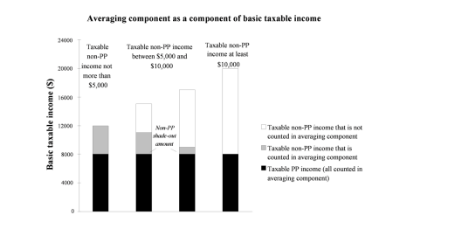 Commonwealth Consolidated Acts
Commonwealth Consolidated Acts Commonwealth Consolidated Acts
Commonwealth Consolidated Acts(1) Your averaging adjustment is a proportion of your gross averaging amount, taking account of:
(a) your taxable primary production income (the part of your basic taxable income from your primary production business); and
(b) your taxable non - primary production income (the part of your basic taxable income from other sources).
Your averaging component is the means of taking into account the different parts of your basic taxable income in working out your averaging adjustment.
(2) If your taxable non - primary production income is less than or equal to $5,000, your averaging component equals the whole of your basic taxable income. (In other words, your averaging component includes all of your taxable primary production income and all of your taxable non - primary production income.)
(3) If your taxable non - primary production income is between $5,000 and $10,000, a shading - out system applies so that your averaging component includes some of your taxable non - primary production income as well as all of your taxable primary production income.
(4) If your taxable non - primary production income is $10,000 or more, your averaging component equals your taxable primary production income. Your averaging component does not include any of your taxable non - primary production income.
(5) The following diagram shows examples of these relationships.

The second and third columns show that as taxable non - primary production income increases above $5,000 (up to a maximum of $10,000), less of it is counted in the averaging component.